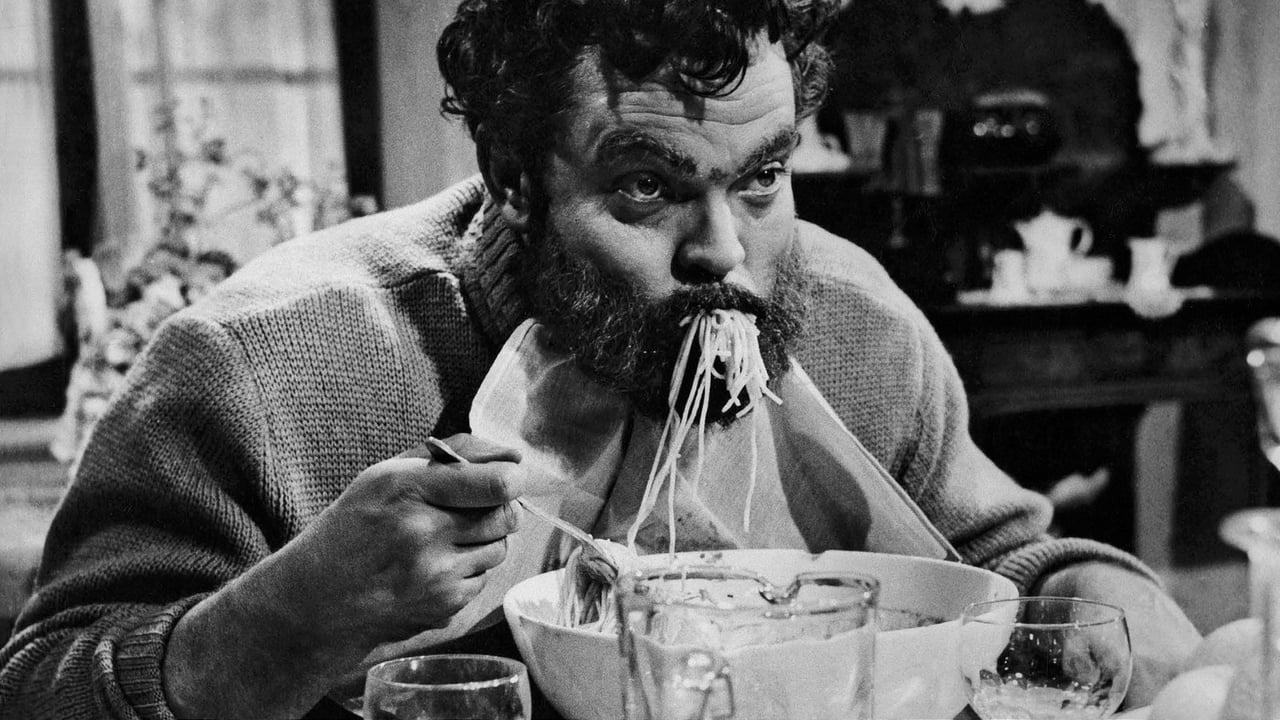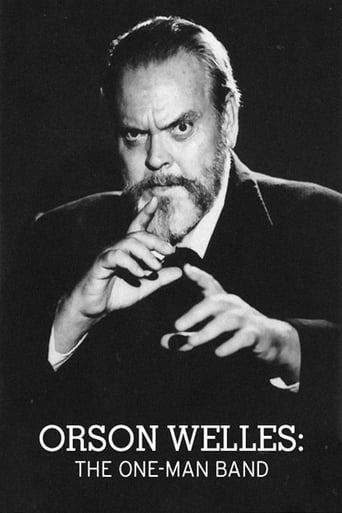

There are women in the film, but none has anything you could call a personality.
... View MoreIt's complicated... I really like the directing, acting and writing but, there are issues with the way it's shot that I just can't deny. As much as I love the storytelling and the fantastic performance but, there are also certain scenes that didn't need to exist.
... View MoreThe performances transcend the film's tropes, grounding it in characters that feel more complete than this subgenre often produces.
... View MoreGreat example of an old-fashioned, pure-at-heart escapist event movie that doesn't pretend to be anything that it's not and has boat loads of fun being its own ludicrous self.
... View MoreOrson Welles: The One-Man Band (1995) *** (out of 4) This is an interesting documentary from Oja Kodar who served as Orson Welles life partner. This 60-minute documentary takes clips from various unfinished films by Welles and presents them as parts of his work that simply for one reason or another never got finished. Throughout all the clips we get some stuff from Welles giving interviews where he talks about his craft. One such clip comes from his AFI Lifetime Achievement award and another comes from a Q&A he was giving and he gives an interesting answer about his unfinished films including DON QUIXOTE. We get clips or notes to films such as THE OTHER SIDE OF THE WIND, MOBY DICK, THE DEEP, THE MERCHANT OF VENICE, ONE-MAN BAND, The Orson Welles Show, THE DREAMERS and a bizarre extended trailer for F FOR FAKE. Needless to say, the ones who will enjoy this the most are fans of Welles because they'll get a chance to see all of this footage, which went pretty much unused for years. I'm sure the success of IT'S ALL TRUE helped get some of this out there. While there's nothing ground-breaking in terms to the quality of the film, I think it remains entertaining as long as you don't mind watching this footage of Welles. I must admit that I thought it was rather sad watching this thing and seeing such a great artist doing stuff that would never come together and eventually sit on a shelf for decades. Kodar is shown on-camera as she shows off some items of Welles as well as some of the paintings that he did. Of course, a more detailed documentary about the life of Welles is certainly something that we need but until then this here is a nice introduction to the work he never completed.
... View MoreWhen a person slowly disappears, nobody seems to notice. This is probably what happened to Orson Welles when his film career stumbled into a downhill slope. The man who was arguably the most brilliant filmmaker to emerge on the American scene, ended up doing narration, wine commercials, and magic shows. He died in poverty, leaving behind masterpieces, but also leaving behind dozens of unfinished films. Films that could have been just as magical as his earlier works. 'Orson Welles - The One Man Band" takes a look at those struggling later years when Welles was a ghost hovering around the Hollywood movie scene. Many people knew he was trying to make movies, but many people also knew he could never get them finished. Because of his inability to finish films, no major studio would try to finance him, so he became a gypsy-like filmmaker. Even still then many projects were not finished. Although it is sad to see a legend struggling so badly, the film does not feel sorry for him. In fact, the film has a very positive outlook on Welles later years. The film is narrator by two people. One is the filmmaker. The other is Welles' companion, Oja Kodar. She had spent a considerable time with Welles in his last years and knew him probably better than anyone else. The image she shows of Welles was not of a burned-out has-been, but of a strong man who still had plenty of creative spark. When watching the snippets and short clips from his unfinished films, one can see exactly what Oja Kodar was seeing. Either it was bad luck or it was his conflicts with studios that could not get his films finished. Or maybe it was both. Regardless, one can see even in his later films, Welles still had incredible film-making talent and vision. One can see that he was also a versatile actor. He could play a wide variety of roles and play them as good as the best actors. When we see how creative he still was, we cannot help but think it was the Hollywood that ruined his career. There could be a lot of truth to this because many people feel he was never the same after 'Citizen Kane' because Welles might have stepped on too many big toes after his brilliant debut feature. But the unknown remains just that. At times, it is the artist who ruins his or her career with their own bare hands. It is hard to say what happened, but this film does not try to explain that either. It tries to focus on Welles the artist. And he was just that until his death. An artist who had no audience. How frustrating, but we have seen this example time and again throughout history.
... View MoreThis is a loving film essay on Orson Welles and his unfinished films. Its an interesting look at the man who was just trying to make the films he wanted to on his own terms. Made with the assistance of Welles' longtime companion Oja Kodar this film lets us see a number of his unrealized projects for the first time. Its a treat for anyone who has been interested in Orson Welles and heard stories of these lost treasures; or for any one curious to what end he was putting the money got from his numerous film and television roles. While I'm not sure what I would have thought of some of the films (The Dreamers for example) I find that I'm very interested in where he was going with other (his Moby Dick, which consisted of him simply reciting passages from the book is an interesting idea). I especially loved some of the short humorous bits that Welles put together, his Churchill film is very funny, as his is bit with two English tailors. As a person who has been very critical of Welles of late, due in large part to extreme disillusionment with his Don Quixote (which I found to be a crashing bore) I find that this film re-awakened my respect for the man. Its not a perfect film, most of the pieces we see only awaken a desire to see more of the unfinished films and at times it seems to go on too long. Still this is a must see if you're interested in Welles or cinema, especially its lost treasures.
... View MoreOrson Welles: The One-Man Band, which is one of many excellent extras on the Criterion Collection DVD edition of Welles' film F for Fake (Vérités et mensonges, 1974), is a 90-minute documentary, put together (co-directed) by Welles partner/companion Oja Kodar and filmmaker Vassili Silovic. It examines Welles' career primarily via a focus on his unfinished projects, and is of great interest to Welles fans for presenting (sometimes extended) clips of those unrealized films. Although this documentary is put together in the style of F for Fake, it's not nearly as successful artistically, which probably underscores what a genius Welles could be when he was in charge.The unfinished or lost works prominently featured include Moby Dick, The Merchant of Venice (1969), The Other Side of the Wind (1972), and a kind of surrealistic "biopic" that Welles was working on, set in London, called One Man Band. There is also a fascinating question and answer session with Welles filmed on a college campus, bits of a television show with him talking to various Muppets (it appears to be more of a talk show than something taken from The Muppet Show), a few instances of Welles performing magic tricks, and quite a few scenes filmed specifically for this documentary. The latter tend to have the best cinematography. The clips from unfinished films that Welles shot or supervised tend to not be properly processed. They need color correction; they need to be cleaned up, and so on.Just seeing the Welles film clips out of context like this tends to undermine their potential impact for me. For example, the surrealistic Merchant of Venice scenes and the bizarre sex scene from The Other Side of the Wind are both fascinating, but with improperly processed prints and with just snippets that should have arrived in a full film in the same vein, neither quite work, and in the context of this documentary, they tend to slow it down too much. The bits of Welles reading sections from Moby Dick at the camera in close-up and the brief scenes from an unrealized film called the Dreamers do not work at all for me. The snippets of One-Man Band are primarily interesting in that they amount to Welles doing his best Benny Hill impersonation.Although I was drawn to the documentary by seeing the unfinished clips, what ended up being the most significant aspect of The One Man Band for me was the exploration of Welles' difficult relationship with the film industry, his occasional bad luck (such as losing or having the negatives of Merchant of Venice stolen), his efforts to fund his projects, which tended to always surmount what he could arrange financing for, and his public comments, which mostly downplayed the unfinished works, and in which he presents himself both as a carefree, somewhat modest "artiste" and a deep pessimist. In some of these respects, Welles had a career similarity to other maverick outsider artists, such as Frank Zappa.Relatively simple shots, such as driving by the outside of the big Hollywood studios and the Director's Guild of America, have significant symbolic impact in this context, as we're seeing the "closed door" to Welles' creative ideals. There are aspects of Welles that I would have liked to see explored more in depth in this documentary, such as his visual artworks (both the works intended as ends in themselves and those intended as tools for film-making), but this is a fairly successful, if somewhat sad and disheartening look at a very unique talent.
... View More